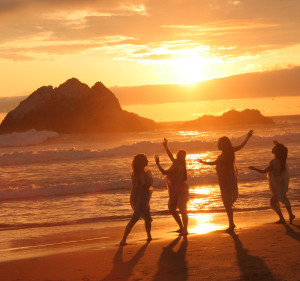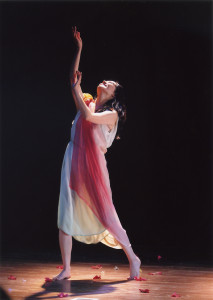It is a typical Sunday afternoon at the Mary Sano Studio of Duncan Dancing. The sounds of Chopin, Gluck and Schubert provide the soundtrack as a light breeze caresses the drawn curtains, and the setting sun grants all the light necessary as dancers begin warming their bodies for today’s session. As I take in the serenity of the scene, my mind wanders to the history of this great tradition, and my personal connection to it.

Photo by Shigeo Seya
ISADORA DUNCAN
Born May 26, 1877 in San Francisco, Isadora Duncan is considered one of the founders of modern dance. Isadora broke from the popular and more rigid dance styles of the day, namely ballet; and developed an original technique centered upon natural and spiritual movement. In her famous essay “The Dance of the Future,” Duncan wrote:
The movement of waves, of winds, of the earth is ever in the same lasting harmony. We do not stand on the beach and inquire of the ocean what was its movement in the past and what will be its movement in the future. We realize that the movement peculiar to its nature is eternal to its nature… The dancer of the future will be one whose body and soul have grown so harmoniously together that the natural language of that soul will have become the movement of the body. The dancer will not belong to a nation but to all humanity. She will dance not in the form of nymph, nor fairy, nor coquette, but in the form of woman in her greatest and purest expression. 1
These words, shared to an audience in Berlin by a then 26 year old Duncan, hinted at the vast impact Isadora would go on to have in her lifetime. Her work would not only revolutionize the philosophy of dance and dance education, but would also affect social progress of her era (particularly the women’s movement). In Isadora: Portrait of the Artist as a Woman, author Fredrika Blair notes: “Finally, as Agnes de Mille wrote, Isadora caused the dance to be considered “important and dignified.” Before Duncan, the dance was considered an entertainment. She left it an art.” 2
My interest in Isadora Duncan was sparked by my practice in modern dance. As an athlete and jazz/hip hop dancer at a young age, I had little interest in ballet technique. To find modern dance, which let me roll on the ground, be barefoot and express strength…now this was a movement I could connect to. At Wesleyan University, I assisted dance professor, scholar and choreographer Pedro Alejandro, who wrote about Isadora Duncan. With this research, I learned Duncan’s teachings were invaluable to the legacy of modern dance as a social project. 3
MARY SANO
My first encounter with an embodied history of Duncan Dance was at the Mary Sano Studio of Duncan Dancing. On October 5th, 2010, I attended Mary Sano’s Duncan Dance Lecture Demonstration and Performance, part of the 24 Days of Central Market Arts Festival. The studio was beautiful: large windows lined by barres on one side and a studio length mirror on the other; a piano in the corner and a gorgeous wood floor. After screening a documentary film about Isadora, which featured Sano, and her studio, the Duncan Dancers performed a few Duncan repertoire pieces. Their tunics fluttered beautifully and their quality of movement felt light yet grounded. They also performed Perseverance, a number from a larger original work Mary was producing titled Ship of Dreams: Kanrin Maru.
Interested to learn more, I started by doing some research on Mary and her past work. She is a third generation Duncan dancer and has been performing and teaching Duncan Dance internationally since 1983. In 1985, Mary moved to San Francisco to study further with Mignon Garland, who founded the Isadora Duncan Heritage Society. After graduating from Mills College with an MA in dance in 1991, she formed Mary Sano and her Duncan Dancers in 1993, and in 1997, opened her school of Duncan dance. Mary also presents bi-annual dance/music festivals at her studio; the Dionysian Festival celebrating Isadora Duncan’s birthday in May; and the Terpsichorean Celebration on the anniversary of the founding of the studio in November of each year.
In our next meeting, Mary told me her first encounter with Duncan Dance was in 1979, when she took a workshop with Mignon on a trip to San Francisco from her native Japan. She had studied many dance techniques, but had never experienced movement so freeing and inspiring. I learned that Duncan dance came to her at a time when she was looking for a more spiritual and creative outlet after several years working as a model and dancer in Japan.
Our conversation then shifted to Mary’s original dance/theater production Ship of Dreams: Kanrin Maru, set to premiere that December at the Brava Theater Center. This evening length production would include live music, acting, video and dance interwoven to tell the historical tale and contemporary significance of the Kanrin Maru voyage, which brought the first Japanese emissaries to the US in 1860. I attended the performance a few weeks later, and enjoyed the beautiful blend of dance, music and storytelling.
FINDING CENTER IN DUNCAN CLASS
Mary’s class cultivates the connections in the Duncan dancer: harmony with body, mind, spirit and environment. One of the first lessons I learned was to move from the Duncan center and to find fluidity in the dance. The Duncan center, located at the solar plexus, is a core component of the technique, as I have learned in hearing Mary repeat to us: “The center moves your body; arms move as a result. Don’t move your arms first.” This distinction in movement initiation helps me expand my technical practice and sense of flow. I discover the challenge in some basic movements’ simplicity, particularly the Duncan walk. Mary instructs: “Lift from the hip, hip is naturally turned out, heavy leg, relax the knee, point the foot down…” She guides us to take each step at a time and to “connect with the earth” on each foot fall. As we walk across the floor, the pattern becomes a type of meditation. She also provides great verbal imagery, going beyond technical instruction. “Open your arms to the infinite sky” or “feel the warmth of the sun on your body as you gaze at the horizon.”

Photo by Atsushi Iijima
When our bodies have become “in tune with the universe,” Mary teaches Duncan choreography, focusing on musicality and performance. She truly emphasizes the importance of listening and understanding the nuances of the music we move to. For example, in the choreography accompanying Gluck’s Dance of the Blessed Spirits, the hands are cupped and raised gradually up from the ground, in front of the face, and toward the ceiling. I remember Mary’s specific instruction for this passage: “Go through the senses.” This reminder to involve the ‘whole’ self in each piece is an essential ingredient in growing as a Sano dancer.
SANO AS CHOREOGRAPHER & ARTISTIC DIRECTOR
After studying with Mary for a few months, I began an internship at her studio and gained greater insight into her creative process. I worked closely with the other dancers in her group, most of whom have studied with Mary for over five years. With a strong footing in the Duncan technique and the harmony between movers, each member brings specific strengths to the group, which lend to the creative palette as Mary develops original works.
I am often impressed by the freedom Mary gives her dancers to explore and create their own movement vocabulary when choreographing new works. For example, I learned that for several scenes in the Kanrin Maru production, she allowed the dancers and actors to score their own natural movement into the choreography. She told me that, “by focusing on a grounded interconnection between the artists’ emotions and their environment around them, we were able to fuse Duncan dance technique, traditional Japanese dance, live music and acting in a powerful way.” While her work is based in the Duncan aesthetic, Mary increasingly integrates different artistic and cultural elements such as Noh Theatre, Indian and Butoh dance, and improvisational theater into her work.
Mary, like Isadora, also derives much inspiration for her work from music and poetry. She often commissions new music, and collaborates closely with her musicians on the details of the sound score. This process usually begins with several improvisational sessions, followed by work-in-progress showings to obtain feedback as the piece begins to take shape. Similarly, she will use poetry (often her own) to spur the creation process. In March of 2011, Sano created the piece When Mother Earth Speaks to Us, based on a poem she wrote in the aftermath of the massive Tohoku earthquake and subsequent tsunami. The piece has a very strong connection to the environment and the persevering spirit of humanity- themes that permeate much of Sano’s recent work.
TOKYO BOUND
In late 2011, Mary informed us she would perform the third installment of her Solo Dance Series in Tokyo in April 2012. I hoped I would be able to travel and see the show. Instead, she presented an opportunity: if we were committed to put in the necessary work, we could perform ensemble choreography in Japan. Amber Held, Junko Sodeyama and I embraced this challenge and began preparing for the show.
After almost four months of intensive rehearsals, I arrived in Tokyo on April 14. We rehearsed with Mary’s Japanese Duncan dance students and the musicians at her studio in Akihabara, a cool Tokyo district famous for its shops for anime and electronics. Mary’s show entitled Dancing Dreaming Isadora premiered on April 21 at the Shinjuku-Kumin Hall in Tokyo. In viewing Sano’s original solos, I noticed a harmony between sound and sight, with references to the natural world. In the scene Fisherman’s Daughter, a video projection overlays Mary’s costume, slightly obscuring the body shape and casting shadows behind her.
Tetsuya Miyata, critic for the Music and Dance Press in Japan, responded to the scene: “The footage was edited by visual effects editor Masao Shigyo, and Sano’s choreography flowed before it with animal-like innocence and grace. Live musical accompaniment, performed by Hideo on Bamboo flute, Izumi Kuribayashi on Violin, and Mamoru Hoshi on Cello and Shino flute, integrated seamlessly with Sano’s movement. While the inspiration for this scene was a visit to China, the work displayed a searching and discovery within Sano’s present state.”
This parallel connection to both the outer world and inner self is at the core of both Sano and Duncan’s work.
From my beginnings as an observer, to a student, intern and then to a company dancer, my experience with Mary Sano and Duncan Dance is one I treasure and continue to nurture. As I develop my artistry in dance, I appreciate Isadora’s impact on dancing generations to come. Mary Sano continues to evolve Isadora Duncan’s legacy as a pioneering artist and teacher. For more information about Mary Sano’s classes & events, see: duncandance.org
Notes:
1. Isadora Duncan, The Art of the Dance, edited by Sheldon Cheney (Theater Arts, New York, NY 1928) 54-63
2. Fredrika Blair, Isadora: Portrait of the Artist as a Woman (McGraw-Hill, New York, NY 1986)
3. Pedro Alejandro, “The Enclosed Garden of Dance Modernism: Isadora Duncan
and the Eco-Feminist Social Project of Early Modern Dance.” Paper presented at 5th Annual Hawaii International Conference on Arts & Humanities, Honolulu, Hawaii. January 2007


